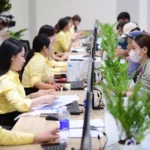The issue of teacher salaries is not just about numbers on a payslip. It’s about how we answer the question: Is the teaching profession truly honored as declared, or is it just an unfulfilled legal promise?
According to a report from the Ministry of Education and Training for 2024, the average monthly income for preschool, primary, and lower secondary school teachers was approximately 6.6 million, 7.3 million, and 7.1 million VND respectively. The average income for civil servants across the entire education sector was about 7.7 million VND/month, still significantly lower than many groups of civil servants in other fields.
The Educator Law separates salary and allowances
While the press continuously reminds that teacher salaries should be the highest, the reality is not yet so.
Point a, Clause 1, Article 23 of the 2025 Educator Law stipulates that teacher salaries are ranked highest in the salary scale and table within public non-business units.
This is not a vague slogan but a mandatory legal norm, with the Government issuing implementation decrees. To realize this spirit, the Ministry of Education and Training proposes applying a special salary coefficient in the draft decree regulating salary policies and allowance regimes for educators.
However, the Ministry of Home Affairs believes that regulating a special salary coefficient for educators lacks legal basis and suggests not breaking the general salary system design for civil servants in the non-business sector.
From a legal perspective, Vietnam’s system of legal documents has a clear hierarchy. Laws enacted by the National Assembly stand higher than Government Decrees.
The Ministry of Education and Training has argued that the policy of prioritizing the highest salary ranking for teachers has been consistently determined for 29 years, from Party resolutions to Resolution 71-NQ/TW dated August 22, 2025, of the Politburo on breakthrough educational development, containing content on special, preferential policies surpassing others for educators.
The Ministry of Home Affairs argues that currently, teachers receive salary allowances from 25-70% (including seniority allowances and professional preferential allowances), so the total salary and salary allowance regimes for teachers are already the highest among non-business sectors.
However, the Educator Law clearly separates salary and allowances. In Clause 1, Article 23 of this Law, point a regulates salary, point b regulates allowances. When the National Assembly says salary is ranked highest, this is a regulation about the basic salary scale, unrelated to allowances.
Adding allowances to salary to prove that teachers already receive the highest is an interpretation inconsistent with the law’s text.
Fundamentally, the teacher salary scale still uses the general salary scale for civil servants, only adding a special coefficient to ensure the principle of highest salary.
Teacher salaries need to be high to attract talent
International experience shows that countries with top-tier education systems place teacher salaries at high levels to attract talent.
In Singapore, teachers are recruited from the group of top students, all trained at the National Institute of Education and receive over 100 hours of professional development each year.
In Finland, only 6.8% of applicants are accepted into teacher training, a rate even lower than for lawyers (8.3%) or doctors (7.3%). Creating scarcity in recruitment has elevated the social status of the teaching profession.
Conversely, in Vietnam, according to data from the Ministry of Education and Training, before 2023, about 10% of teachers left the profession or changed careers, of which 61% were under 35 years old. Many localities lack recruitment sources; fields like foreign languages, informatics, fine arts, and music are often difficult to recruit for.
Although the Educator Law has been enacted and is about to take effect, there are still many unclear points that need clarifying guidance from a decree.
First is the transition mechanism from the current salary table to the new one. If a special coefficient is applied, how will teachers currently at different salary levels be adjusted to ensure fairness?
Second is financial resources. With 1.2 million educators, any adjustment significantly impacts the budget. How to balance the desire to improve benefits with the state budget’s payment capacity, especially in the context of organizational restructuring






